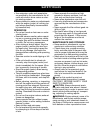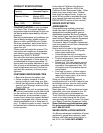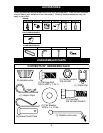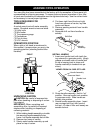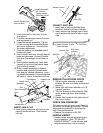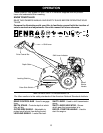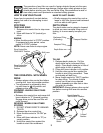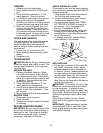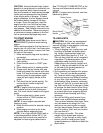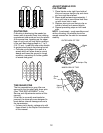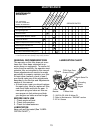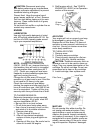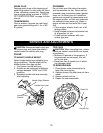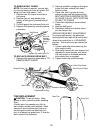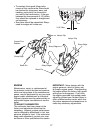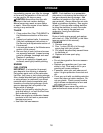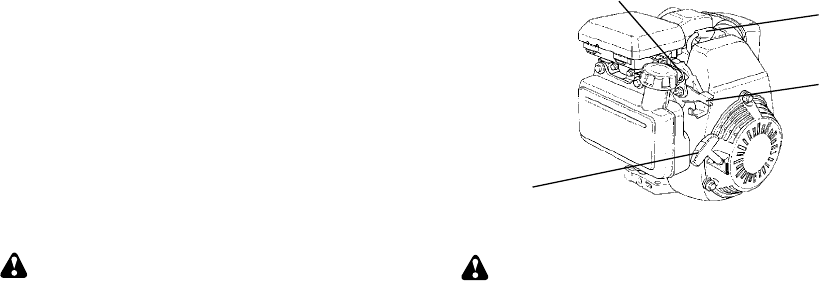
11
TILLING HINTS
CAUTION: Until you are accustomed
to handling your tiller, start actual fi eld
use with throttle in slow position (mid-way
be tween “FAST” and “IDLE”).
• Tilling is digging into, turning over, and
breaking up packed soil before plant-
ing. Loose, unpacked soil helps root
growth. Best tilling depth is 4" to 6". A
tiller will also clear the soil of un want ed
vege ta tion. The de com po si tion of this
veg e ta ble mat ter enriches the soil.
De pend ing on the climate (rain fall and
wind), it may be advisable to till the soil
at the end of the growing season to
fur ther condition the soil.
• Soil conditions are important for proper
tilling. Tines will not readily penetrate
dry, hard soil which may con trib ute to
ex ces sive bounce and diffi cult handling
of your tiller. Hard soil should be mois-
tened before tilling; however, extremely
wet soil will “ball-up” or clump during till-
ing. Wait until the soil is less wet in or der
to achieve the best results. When till ing
in the fall, re move vines and long grass
to prevent them from wrapping around
the tine shaft and slowing your till ing
operation.
• You will fi nd tilling much easier if you
leave a row untilled between passes.
Then go back between tilled rows.There
are two reasons for doing this. First,
wide turns are much easier to negoti-
ate than about-faces. Second, the tiller
won’t be pulling itself, and you, to ward
the row next to it.
• Do not lean on handle. This takes
weight off the wheels and reduces
trac tion. To get through a really tough
sec tion of sod or hard ground, apply
up ward pressure on handle or lower the
depth stake.
TO START ENGINE
CAUTION: Keep drive control bar in
“DISENGAGED” po si tion when starting
engine.
When starting engine for the fi rst time or if
engine has run out of fuel, it will take ex tra
pulls of the recoil starter to move fuel from
the tank to the engine.
1. Make sure spark plug wire is prop er ly
connected.
2. Move shift lever indicator to “N” (neu-
tral) position.
3. Place throttle control in “FAST” posi-
tion.
5. Move choke control to choke position.
5. Grasp recoil starter handle with one
hand and grasp tiller handle with other
hand. Pull rope out slowly until engine
reaches start of compression cycle
(rope will pull slightly harder at this
point).
6. Pull recoil starter handle quickly. Do
not let starter handle snap back
against starter.
NOTE: If engine fi res but does not start,
move choke control to half choke posi-
tion. Pull recoil starter handle until engine
starts.
7. When engine starts, slowly move
choke control to “RUN” position as
engine warms up.
NOTE: A warm engine requires less
chok ing to start.
8. Move throttle control to desired running
position.
9. Allow engine to warm up for a few
min utes before engaging tines.
NOTE: If at a high altitude (3000 feet) or
in cold tem per a tures (below 32°F), the
car bu re tor fuel mix ture may need to be
ad just ed for best engine per for mance.
Choke Control
Recoil Start er
Han dle
CAUTION: Alcohol blended fuels (called
gasohol or using ethanol or methanol) can
attract moisture which leads to separa-
tion and for ma tion of acids during storage.
Acidic gas can damage the fuel system
of an engine while in storage. To avoid
engine problems, the fuel system should
be emptied before stor age of 30 days
or longer. Drain the gas tank, start the
engine and let it run until the fuel lines
and carburetor are empty. Use fresh fuel
next season. See Storage In struc tions for
additional information. Never use engine
or carburetor cleaner products in the fuel
tank or permanent damage may occur.
See “TO AD JUST CARBURETOR” in the
Service and Ad just ments section of this
manual.
NOTE: If engine does not start, see trou-
ble shoot ing points.
Spark
Plug
Throttle
Control



